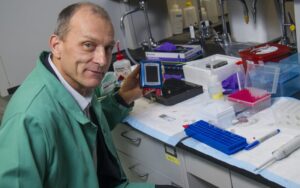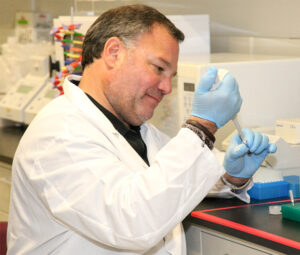The Research Connection – September 2021: Aging-Related Technologies Research Edition
Featured university R&D projects:
- A simple test for diagnosing Alzheimer’s disease
- Uncovering new treatment strategies for dementia
- Understanding the origins of Alzheimer’s disease
This edition’s contributors:
- SUNY Research Foundation
- University at Albany
- SUNY Polytechnic Institute
- SUNY Empire State College
A simple test for diagnosing Alzheimer’s disease
 Until recently, tests to detect Alzheimer’s disease before symptoms appeared were expensive, invasive and largely limited to research settings. University at Albany professor Igor Lednev has created a noninvasive test that can diagnose Alzheimer’s in its earliest stages.
Until recently, tests to detect Alzheimer’s disease before symptoms appeared were expensive, invasive and largely limited to research settings. University at Albany professor Igor Lednev has created a noninvasive test that can diagnose Alzheimer’s in its earliest stages.
His technology, patented in 2018, relies on a combination of advanced statistics and “Raman Hyperspectroscopy,” a spectroscopic technique that analyzes scattered light by shining lasers on such samples as dry traces of blood or saliva. In a proof-of-concept study published in the Journal of Biophotonics and Journal of Alzheimer’s Disease, and funded by the National Institutes of Health, Lednev’s technology identified the samples correctly at a rate of over 95 percent. Lednev and his team started auUniversity spinoff Early Alzheimer’s Diagnostics LLC and look for funding to further develop and commercialize their patented technology. Explore partnership opportunities with UAlbany.
Potential applications: Diagnostic
Contact: Professor Igor Lednev, ilednev@albany.edu
Uncovering new treatment strategies for dementia

SUNY Empire Scholar Wei-Dong Yao was awarded over $600,000 from the National Institutes of Health to support his research on frontotemporal dementia (FTD), the most common form of dementia after Alzheimer’s disease.
Yao’s study at Upstate Medical University represents the first attempt to investigate the role of a new disease gene in FTD pathogenesis. The proposed studies are fundamentally important and highly significant because they have the potential to uncover novel pathogenic mechanisms and treatment strategies for FTD and related neurodegenerative diseases. Support this research, collaborate with the research team.
Potential applications: Therapeutics
Contact: Dr Wei-Dong Yao, yaow@upstate.edu
Understanding the origins of Alzheimer’s disease

SUNY Polytechnic Institute Interim Dean of the College of Nanoscale Science and Engineering Dr. Andrés Melendez and Head of Nanobioscience Dr. Scott Tenenbaum received $320,000 from the National Institutes of Health to develop a switching mechanism that is attached to messenger RNA. Called sxRNA, this molecular tool enables the marking of cells in the body that could be involved in the processes that lead to Alzheimer’s disease, allowing them to be monitored in real time.
As cells in the body age and begin to show signs of senescence, or deterioration, they begin to stop dividing and can produce certain chemicals that influence other cells to senesce. This research could help to show whether Alzheimer’s disease is already present to cause such biological reactions, or if the senescent processes lead to Alzheimer’s. Support this research, collaborate with the research team.
Potential applications: Therapeutics
Contact: Dr. Andrés Melendez: jmelendez@sunypoly.edu or Dr. Scott Tenenbaum: tenenbs@sunypoly.edu
About The Research Connection: The Research Connection is a quarterly feature in the Center for Economic Growth’s monthly, online newsletter, The CEG Indicator. This special feature highlights R&D being conducted by researchers at Capital Region colleges and universities and others throughout the SUNY system. The Research Connection spotlights academic R&D in CEG’s focus technology sectors: Nanotechnology and Semiconductors, Cleantech/Energy, Biotechnology, Advanced Materials, Population Health Technology and Information Technology.
Each edition of The Research Connection will highlight several research projects in a specific technology sector. The Research Connection will keep CEG investors (2,500+) and CEG Indicator subscribers (9,000+) informed on the cutting-edge R&D that is being conducted by SUNY and other academic researchers that could potentially transform their industries. It will also encourage collaboration, patent, licensing and other opportunities.
Don’t miss these insights into the trends that are shaping the Capital Region’s economy. Sign up for CEG’s e-news and follow us on:














